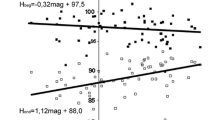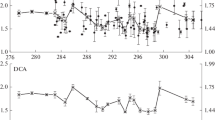Abstract
The hyperbolic meteor orbits among the 4,581 photographic and 62,906 radar meteors of the IAU MDC have been analysed using statistical methods. It was shown that the vast majority of hyperbolic orbits has been caused by the dispersion of determined velocities. The large proportion of hyperbolic orbits among the known meteor showers strongly suggests the hyperbolicity of the meteors is not real. The number of apparent hyperbolic orbits increases inversely proportional to the difference between the mean heliocentric velocity of meteor shower and the parabolic velocity limit. The number of hyperbolic meteors in the investigated catalogues does not, in any case, represent the number of interstellar meteors in observational data. The apparent hyperbolicity of these orbits is caused by a high spread in velocity determination, shifting a part of the data through the parabolic limit.
Similar content being viewed by others
1 Introduction
The present work is based on the meteor orbits data collected in the IAU Meteor Data Center (MDC). The database contains 4,581 photographic and 62,906 radar meteor orbits (Lindblad et al. 2005). Among the photographic orbits, there are 527 (11.5%) orbits with eccentricity e > 1. Radar orbits contain 1,875 (2.98%) hyperbolic orbits.
The proportion of hyperbolic orbits differs in different catalogues in the MDC and shows a dependence on the quality of observations (Štohl 1971). From a detailed analysis of the hyperbolic orbits in MDC photographic and radar data (Hajduková 1994; Hajduková and Paulech 2007), it was made clear that many hyperbolic orbits are probably a consequence of errors in determination of the meteor velocity or other parameters. Many conclusions based on the highly hyperbolic orbits derived from radar observations do not take into account the sensitivity of radar methods of velocity determination (Hajduk 2001) and, therefore, they do not allow us to have much confidence to the derived results, especially those concerning interstellar sources of high velocity meteors. Our task here will be to estimate the limits of the possible errors.
2 Hyperbolic Orbits and Meteor Showers
One of the best ways of proving false hyperbolicity is to find the hyperbolic meteors among those meteors fulfilling the criteria of belonging to meteor showers.
There are 527 hyperbolic orbits in the photographic catalogues of the MDC and approximately 50% of them belong to known meteor showers. The proportion of hyperbolic orbits in the database is different in different showers. Among the total of 832 photographic Perseids, there are 224 hyperbolic orbits, which represent 27%, but among the 386 Geminids (v HGem = 36.6 km s−1), there is only 1 case of hyperbolic orbit. The problem of Perseids is that their heliocentric velocity (41.72 km s−1) differs from the parabolic limit v p = 42.14 km s−1 only by 0.4 km s−1 and, hence, a small error in the velocity determination may result in a designation of hyperbolicity of orbit. The present work examines five meteor showers having heliocentric velocities v H close to the parabolic limit \(\sqrt{2} v_0,\) where v 0 is the Earth’s velocity. The data are shown in Table 1. In our analysis the shower characteristics given by Ceplecha et al. (1998) were used in the same way as they were earlier when searching the MDC photographic data (Hajduková 2002).
Figure 1 shows an increasing number of hyperbolic orbits as inversely proportional to the difference \((\Delta v = v_H - \sqrt{2} v_0)\) between the parabolic velocity and the mean velocity v H of particular shower meteors. Figure 1 explains that the proportion of hyperbolic, or, as we can now say, of formal hyperbolic orbits, increases with the increasing heliocentric velocity (N e>1/N = f(v H )) of a particular shower, approaching the parabolic velocity limit.
The dependence of the contribution of hyperbolic meteor orbits in the selected meteor showers in the MDC photographic data on the mean heliocentric velocity of particular meteor showers. This dependence is clear proof that hyperbolic orbits among shower data are the consequence of the error distribution in the velocity determinations
Figure 2 shows eccentricities and geocentric velocities for photographic data of the 5 selected meteor showers. The plots show a considerable dispersion in both parameters. The largest spread of values is seen for the Perseids, reaching a value of 15 km s−1, which correspond to errors in velocity of 17–20%. This is a strong finding, because the authors of individual photographic catalogues of orbits usually speak about a standard error in the geocentric velocity determination corresponding to the value of ± 0.5 km s−1. The dependence of eccentricities on non-atmospheric velocities for radar data in Fig. 2 shows much larger scatter, following from a much smaller number of shower meteors in radar catalogues.
The observation of “hyperbolic meteors" among the shower meteors suggests that a similar effect of erroneously-determined “hyperbolic orbits" should also be ascribed to the sporadic meteors, at least for those the velocities of which are not too far from the parabolic limit.
3 The Velocity Distribution
The different precision of measurements, depending on the quality of observations, causes a natural spread in the velocity distribution. The shape of this spread gives a scattered gaussian distribution, which in the vicinity of the parabolic limit of the velocity, as it is in cases of investigated showers, exceeds the difference Δv between the mean heliocentric velocity of a particular meteor and the parabolic velocity, resulting in it being designated a “hyperbolic orbit". The velocity distribution of the Harvard 39 145 radar meteors and 970 hyperbolic meteors of the same sample, visualized here in the same proportion, is shown in Fig. 3. The velocity distribution of meteors with eccentricity e > 1 follows exactly the distribution of all meteors, but they are shifted by about 10 km s−1 towards the larger velocities along the whole scale. The only logical explanation for the observed shift between both sets of data is that the hyperbolicity of the set of meteors with e > 1 is caused by a high spread in velocity determinations, shifting a part of the data through the parabolic limit. The suggestion that the errors in the determination of v inf from radar observations for high velocity meteors may be as large as 10 km s−1 does have some independent support. We have found it through the analysis of meteors belonging to the known meteor showers. A similar shift of the velocities of meteors with e > 1 from all the meteors was found by Kashcheyev and Kolomiyets (2001), who analysed 250 000 radar meteors from Kharkov.
4 Conclusions
Statistical analysis of the IAU Meteor Data Center photographic and radar meteor data shows that the vast majority of orbits in catalogues recorded as hyperbolic with e > 1 are only the consequence of measurement errors and their hyperbolicity is not real. The above identification of measurement errors as large as 10 km s−1 in the velocity of high velocity meteoroids has some consequences:
Firstly, the flux of interstellar meteors is much lower than it was declared by the authors of catalogues, or believed in some analyses of these observations. Secondly, the number of hyperbolic meteors (with e > 1) in the investigated catalogues of IAU MDC does not in any case represent the number of interstellar meteors in observational data. Hyperbolic meteors cannot be automatically counted as interstellar meteors without making detailed analysis of the data. It is clear that interstellar meteors may be present also within the error bars, however, they cannot be identified.
References
Z. Ceplecha, W.G. Elford, D.O. Revelle, R.L. Hawkes, V. Porubčan, M. Šimek, Meteor phenomena and bodies. Space Sci. Rev. 84, 327–471 (1998)
A. Hajduk, On the very high velocity meteors. in Meteoroids 2001 Conference, ESA SP - 495, ed. by B. Warmbein, (Kiruna, 2001), pp. 557–559
M. Hajduková Jr., On the frequency of interstellar meteoroids. Astron. Astrophys. 288, 330–334 (1994)
M. Hajduková Jr., Shower meteor data in the IAU MDC. Acta Astron. et Geophys. Univ. Comenianae, XXIV, 33–39 (2002)
M. Hajduková Jr., T. Paulech, Hyperbolic and interstellar meteors in the IAU MDC radar data. Contrib. Astron. Obs. Skalnate Pleso 37, 18–30 (2007)
B.L. Kashchejev, S.V. Kolomiyets, Interstellar particle detection and selection criteria of meteor streams. in Meteoroids 2001 Conference, ESA SP - 495, ed. by B.Warmbein, (Kiruna, 2001), pp. 643–650
B.A. Lindblad, L. Neslušan, V. Porubčan, J. Svoreň IAU Meteor Database of photographic orbits - Version 2003. Earth, Moon and Planets 93, 249–260 (2005)
J. Štohl, On the problem of hyperbolic meteors. Bull. Astron. Inst. Czechosl. 21, 10–27 (1971)
Acknowledgements
This work was supported by the Scientific Grant Agency VEGA, grant No 3067.
Author information
Authors and Affiliations
Corresponding author
Rights and permissions
About this article
Cite this article
Hajduková, M. Meteors in the IAU Meteor Data Center on Hyperbolic Orbits. Earth Moon Planet 102, 67–71 (2008). https://doi.org/10.1007/s11038-007-9171-5
Received:
Accepted:
Published:
Issue Date:
DOI: https://doi.org/10.1007/s11038-007-9171-5







